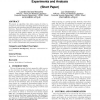Free Online Productivity Tools
i2Speak
i2Symbol
i2OCR
iTex2Img
iWeb2Print
iWeb2Shot
i2Type
iPdf2Split
iPdf2Merge
i2Bopomofo
i2Arabic
i2Style
i2Image
i2PDF
iLatex2Rtf
Sci2ools
ATAL
2008
Springer
2008
Springer
A coordination mechanism for swarm navigation: experiments and analysis
We present an algorithm that allows swarms of robots to navigate in environments containing unknown obstacles, moving towards and spreading along 2D shapes given by implicit functions. Basically, a gradient descent approach augmented with local obstacle avoidance is used to control the swarm. To deal with local minima regions, we use a coordination mechanism that reallocates some robots as "rescuers" and sends them to help other robots that may be trapped. The main objective of this paper is to analyze the performance of this algorithm in terms of its completion rate and communication requirements as the number of robots increases. For this, a series of simulations are presented and discussed. Categories and Subject Descriptors I.2.9 [Artificial Intelligence]: Robotics--Autonomous vehicles General Terms Algorithms, Experimentation Keywords Swarms, Multi-Robot Coordination
Related Content
| Added | 12 Oct 2010 |
| Updated | 12 Oct 2010 |
| Type | Conference |
| Year | 2008 |
| Where | ATAL |
| Authors | Leandro Soriano Marcolino, Luiz Chaimowicz |
Comments (0)

